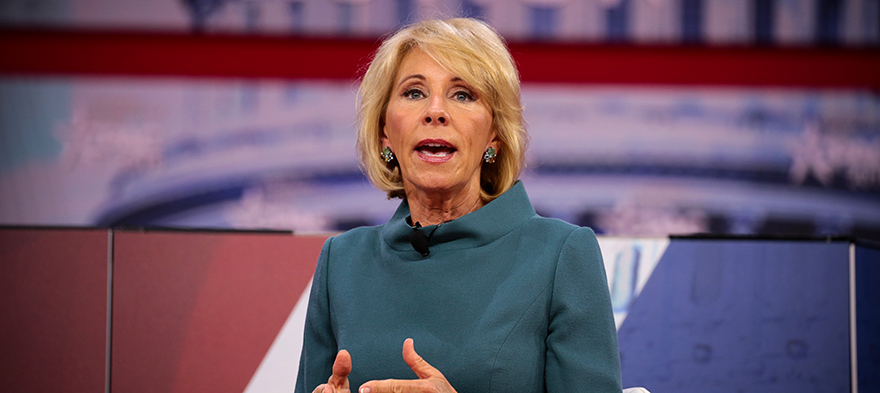
Mar 22, 2018 12:00:00 AM
'ESSA was enacted partially in response to the widespread calls from state school chiefs—including many in this room—to give you the flexibility and opportunity to address your state’s unique challenges,' Ms. DeVos said in an address to the Council of Chief State School Officers. 'Well, this law gives you that chance. The trouble, I don’t see much evidence that you’ve yet seized it.' It was the first time that Ms. DeVos has offered her opinions on the quality of state plans under the new law, which freed states from the punitive and prescriptive federal mandates of the George W. Bush-era No Child Left Behind Act. But what Ms. DeVos called 'tough love' policy experts and observers called the ultimate display of a frustrated federalist.DeVos’ department has approved 33 state plans (along with D.C.'s and Puerto Rico's), and 17 states are still refining their proposals. But it’s go-time for ESSA, and it’s clear that too many states are not following the intent—or even the letter—of the law. As Sen. Patty Murray, the ranking Democrat on the Senate Health, Education, Labor and Pensions Committee, pointed out:
Murray said she was particularly peeved by states ignoring a key part of the law requires them to identify three distinct categories of schools for improvement: the bottom 5 percent of schools, all schools where one subgroup of students is consistently underperforming and schools where any subgroup is performing as poorly as the bottom 5 percent. 'But plans are being approved that violate this,' she said. 'If the department is ignoring the agreement we made in the law and just choosing to implement whatever it feels like–which I believe they are in their approval of state plans so far–then this committee needs to hear from the secretary about how she intends to follow the laws that Congress agrees to.'Independent reviews suggest that “ESSA plans, now on the brink of implementation, are both ‘underwhelming and uneven.’” One of these reviews, Check State Plans, “found state ESSA plans to be mostly uncreative, unambitious, unclear or unfinished.” So in this sea of compliance and conformity, are there any promising signs? There’s one innovation we can get excited about—something that received very little attention when ESSA was first passed, but could shine a very bright light on the disparities in school-by-school spending.
School-by-school spending figures may fuel debates over teacher-seniority and -placement policies, how much value lawmakers place on some children's education and whether principals are most effectively using money to boost academic results.States have long reported per-pupil funding at the district level, and this transparency revealed wild variations in spending because of the over-reliance on property taxes. But starting next December, school districts will have to dig deeper and publicly report how they are divvying up money to individual schools. It’s long overdue, but are states going to step up and get their books in order? Or are they going to try to dodge this requirement? And if they do, are you going to do your job, Secretary DeVos, or give them a pass from “federal overreach”?
Tracy Dell’Angela is a writer, education nonprofit executive director and a mom passionate about education improvements. Previously, Tracy was Director of Outreach and Communications for the Institute of Education Sciences (IES) at the U.S. Department of Education in Washington, D.C. She came to IES from the University of Chicago Consortium on Chicago School Research, which produces research that drives improvement in Chicago and nationwide. She also served as Senior Project Director for 100Kin10 at the University of Chicago and was Director of Program Investments and Partnerships for the Chicago Public Education Fund. Tracy spent most of her career as an award-winning newspaper journalist, including 12 years at the Chicago Tribune as an education reporter covering national policy and the Chicago Public Schools. A Californian by birth but a Chicagoan in spirit, Tracy attended University of Chicago as a master's student in social sciences and earned a B.A. in journalism and political science from San Diego State University.
Few issues in education spark more tension and debate than standardized testing. Are they a tool for equity or a burden on students? A necessary check on school systems or a flawed measure of...
Charter schools are public schools with a purpose. Operating independently from traditional school districts, they're tuition-free, open to all students, and publicly funded—but with more flexibility...
Despite the benefits of a diverse teaching force, prospective teachers of color fall out of our leaky preparation pipeline at every stage: preparation, hiring, induction, and retention. Here’s what...
Ed Post is the flagship website platform of brightbeam, a 501(c3) network of education activists and influencers demanding a better education and a brighter future for every child.
© 2020-2025 brightbeam. All rights reserved.
Leave a Comment